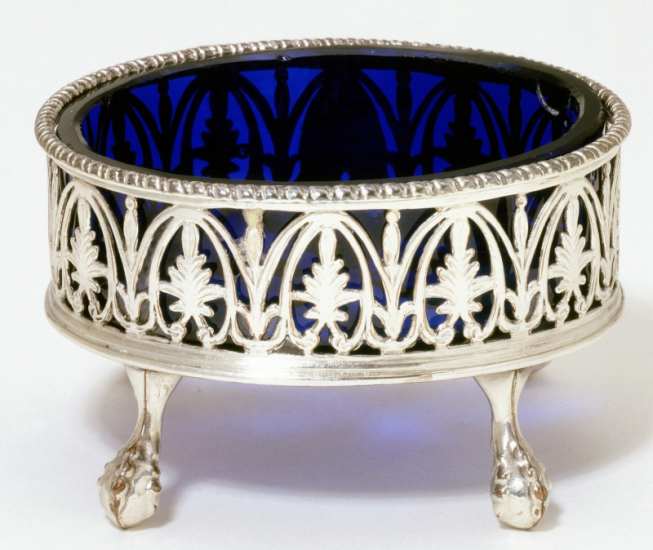The search for a silver substitute was prompted by the increasing prosperity of the 18thC middle classes and led to the invention of Sheffield Plate by Thomas Boulsover c.1743. The new material was made by fusing a sheet of sterling silver to an ingot of copper in a furnace. The resulting material was then rolled or hammered into a sheet and made up into both decorative and practical objects, using the power of the new technologies of the time.
The “double sandwich” form of Sheffield Plate was developed around 1770. Used for pieces such as bowls and mugs that had a visible interior , it consisted of a sheet of silver each side of a piece of copper; early manufacturers applied a film of solder over the bare edge of copper although such pieces are very rare. Later on, borders were applied with a U-shaped section of silver wire to conceal the copper which can be felt as a lip on the underside.
From the end of the 18thC the borders of Sheffield Plate pieces became increasingly ornamental, more so than on sterling silver wares, probably because they could be produced far less expensively than solid silver borders. Borders should be carefully examined for wear. A little copper showing is generally considered attractive, but more than that is not. The decoration of Sheffield Plate is always flat-chased, and the pattern should be visible on the underside of the piece. Engraving is not a feature of Sheffield Plate (except for coats of arms), as it would have meant cutting through to the copper base.
In early pieces the copper showed through where coats of arms were engraved, but from the end of the 18thC a more heavily plated disc, which could take the engraving, was let into the piece. In the Regency period this method was superseded by letting in a pure silver oblong; this can be easily seen as the rest of the object has a surface of sterling standard (92.5%), it oxidizes at a different rate from the pure silver part.
Most pieces of Sheffield Plate hollow ware, such as candlesticks and coffeepots, have a visible seam. If no seam is visible, the article has either been re-plated and the seam covered up in the process, or it is not Sheffield Plate. Some articles have a liner – for example, urns. Once this is removed, a dull leadish colour, caused by tin, should be visible on the inside. A silver colour inside indicates re-plating.
Much of Sheffield Plate is unmarked although some makers used a symbol. Some early 19thC Sheffield Plate had marks that resembled those used on sterling silver. A piece with “Sheffield Plate” stamped on it is electroplate made in Sheffield since the 19thC, rather than genuine Sheffield Plate.
The end of Sheffield Plate was signified by the discovery of electroplating in the 1840’s. By the time of the Great Exhibition of 1851 almost no Sheffield Plate was exhibited , electroplate being the new fashion.
Electroplate
This method of plating silver was used from c.1840 and gradually replaced Sheffield Plate, which after the Great Exhibition of 1851 became increasingly rare. Electroplating creates a coating of pure silver which is whiter and harsher in appearance than the softer glow of Sheffield Plate. The process involves covering one metal with a thin layer of silver by electro-deposition. The laws of electrolytic deposition had been formulated by Faraday as early as 1833 and the process was patented by the Elkington company of Birmingham in the mid 19thC.
In 1836 G.R. Elkington applied for a number of patents for “an improved method of gilding copper, brass, and other metals or alloys of metals” by electrolysis and in 1840 he took out a patent for a new process of depositing silver by electrolysis, a discovery which he had made in collaboration with John Wright, following work he had carried out for the London maker Benjamin Smith.
The base metal was initially copper, subsequently nickel was used, hence the term EPNS (Electro-Plated Nickel Silver). Britannia Metal , an alloy of tin, copper, antimony and zinc is quite often found bearing the stamp EPBM.
Styles followed those that were most popular in silver. The most popular electroplated items are cake baskets, candlesticks and entree dishes. Tea sets are becoming increasingly popular. Being far less expensive even than Sheffield Plate, electroplated wares are not collected for their intrinsic worth but as inexpensive silver- style items. Electroplated flatware services provide the only alternative to silver, as it proved impossible to make flatware in Sheffield Plate without a large ugly seam. Flatware patterns tended to follow the styles of their Sterling counterparts.
Unlike Sheffield Plate, most electroplate has makers’ marks and indications of quality such as “A1” “EP” or “EPNS” Some silversmiths made both electroplate and Sterling silver – for example, James Dixon & Sons, Elkington, and Walker & Hall. Although the marks used were similar on both their silver and their electroplates, the marks are applied in a noticeably different way.







